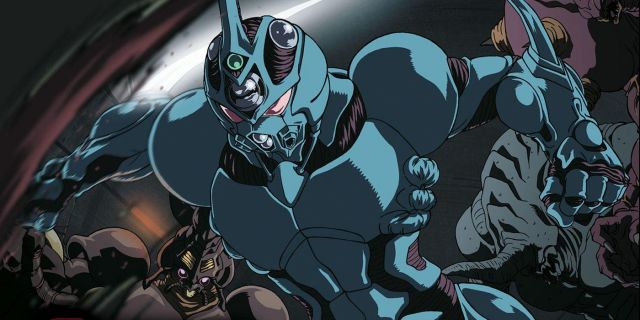Many classic manga and anime franchises got their start in the 1980s, subsequently being brought over to Western countries in the following years. These were the anime that many Western youth and young adults grew up with, defining their perception of the medium. One less-remembered but still important series to make waves during this time was Bio-Booster Armor Guyver.
Combining elements of Japanese tokusatsu superheroes with gruesome body horror, Guyver was unlike anything preceding it in both the East and the West. Unbeknownst to many, the original manga for the series is still running to this day, continuing its trend of biomechanical body horror that’s become more popular than ever. Here’s a look at what Guyver is about and how it subtly defined anime — and even other franchises — for years to come.
What Is Bio-Booster Armor Guyver About?

The story of Guyver involves a “Zoanoid” escaping to Earth with three Guyver units, causing the Cronos Corporation to hunt after him. One of the humans who comes into contact with a Guyver unit is protagonist Sho Fukamachi, who accidentally activates its power. This causes the device to forcefully bond with Sho, encasing him in a biomechanical, almost insectoid armor. Sho would reluctantly use the armor’s powers to defend his friends and family, all of whom become targets due to his bonding with the Guyver unit.
Sho himself has no real interest in any abject heroism, actually wishing to be rid of the painful suit. His lack of any trite sense of “justice” or similar attributes makes him very different from more traditional heroes, added onto only by design. The enemies he faces are many times just as monstrous in appearance, highlighting the grotesque nature of their combat. Later in the series, the villain Cronos actually takes over the world, making Guyver an outlaw vigilante.
Why Is the Guyver Franchise Such a Classic in Manga and Anime?

Created by Yoshiki Takaya, Guyver first began its run in 1985 and is still tentatively going to this day, albeit delayed by a potentially permanent hiatus. Unfortunately, its 32 volumes have not been released outside Japan, but that hasn’t kept the character from being an international anime icon. The short film Guyver: Out of Control, brought to the West in the early 1990s, is most definitely a product of its time. Full of rather gory, intense action, it was nothing like what kids in the West were used to from their cartoons.
As mentioned, Sho didn’t want to be a hero, even looking slightly more like a villain. Likewise, the level of violence and body horror gave Guyver a certain “edge,” contrasting even the more straight-laced tokusatsu shows that the series was seemingly based on. The story is extremely dark overall, and the tiny glimpse of this from Out of Control likely made an impression on those in the West in terms of animation’s potential.
The nature of its body horror and insectoid designs were reflected in much of the concept art from mecha anime at the time. For example, the toyline Armored Insect Corps Beetras — from which some Generation 1 Transformers toys were taken — had concept art for characters who would fit right into the world of Guyver. Similarly, the biomechanical aesthetic of Guyver helped to inspire the designs in a later Transformers series, Beast Wars.
Other anime that followed this trend include Dunbine, a series whose mechs combined an insectoid look with medieval suits of armor. Nowadays, the easiest way to get into the series is through the 2005 Guyver anime, which can be streamed on Funimation. Body horror is more popular than ever in anime and manga, through a collection dark, gritty shonen series and the increasing popularity of Junji Ito’s works. The disgusting superheroics of Guyver are the best of both worlds, presenting a reluctant hero whose visage is synonymous with the rise of alternative animation in the ’90s.















Leave a Reply